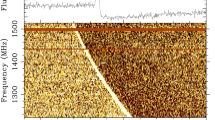Abstract
The suggestion1 that the twin QSOs 0957 + 561 A, B, which are separated by ∼6 arc s and have emission redshifts 1.41, are images of a single QSO formed by a gravitational lens now seems to be generally accepted. This is a result of a wide range of data including optical spectroscopy2,3 and, more particularly, direct imaging by CCD camera4 and image-intensified photography (A. Stockton, personal communication) which reveal a galaxy, Gl, with mr ∼ 18.5 within 1 arc s of the QSO B. G1 can account for the splitting of the images4. It is the brightest member of a cluster4, has a redshift 0.375 ± 0.005 (ref. 3) and IR observations confirm that it is a giant elliptical5,6. The flux density ratio of the two QSO components is nearly constant, B/A ≃ 0.75, from ∼3,000 Å (ref. 7) to decimetre wavelengths8,9, as expected for gravitational imaging. The first radio maps10,11 showed a complex structure and their initial interpretation was ambiguous, but there now seems to be agreement on the overall interpretation4,11,12 in terms of gravitational imaging. Early observations at 408 MHz (ref. 10) suggested the flux tensity ratio of the two QSO components may differ significantly from that at shorter wavelengths, which would cast doubt on the gravitational lens interpretation. Recent observations at 5 GHz (ref. 13) indicate a point source 1 arc s from QSO B, coinciding closely with the position of Gl. We present here a 408-MHz map which provides spectral information on all components of the radio source, removes the doubt raised by the earlier 408 MHz observations and sheds light on the nature of the source coincident with G1.
Similar content being viewed by others
References
Walsh, D., Carswell, R. F. & Weymann, R. J. Nature 279, 381 (1979).
Weymann, R. J. et al. Astrophys. J. Lett. 233, L43 (1979).
Wills, B. J. & Wills, D. Astrophys. J. 238, 1 (1980).
Young, P. et al. Astrophys. J. (in the press).
Soifer, B. T. et al. Nature 285, 91 (1980).
Lebofsky, M. J. et al. Nature 285, 395 (1980).
Gondhalekar, P. M. & Wilson, R. Nature 285, 461 (1980).
Porcas, R. W. et al. Nature 282, 385 (1979).
Burke, B. F., Greenfield, P. E. & Roberts, D. H. Bull. Am. astr. Soc. 11, 620 (1980).
Pooley, G. G. et al. Nature 280, 461 (1979).
Roberts, D. H., Greenfield, P. E. & Burke, B. F. Science 205, 894 (1979).
Greenfield, P. E., Roberts, D. H. & Burke, B. F. Science 208, 495 (1980).
Greenfield, P. E., Burke, B. F. & Roberts, D. H. Nature 286, 865 (1980).
Davies, J. G., Anderson, B. & Morison, I. Nature 288, 66–68 (1980).
Cornwell, T. J. & Wilkinson, P. N. Mon. Not. R. astr. Soc. (submitted).
Keel, W. IAU Circ. No. 3481 (1980).
Porcas, R. W. et al. Nature (submitted).
Author information
Authors and Affiliations
Rights and permissions
About this article
Cite this article
Noble, R., Walsh, D. MTRLI observations of the double QSO at 408 MHz. Nature 288, 69–70 (1980). https://doi.org/10.1038/288069a0
Received:
Accepted:
Issue Date:
DOI: https://doi.org/10.1038/288069a0
- Springer Nature Limited





